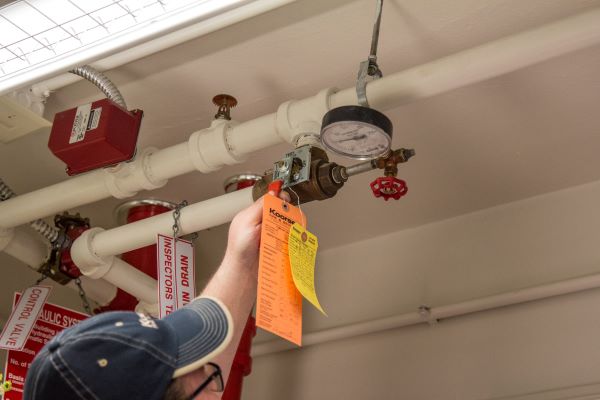Fire sprinkler systems are a cornerstone of building safety, offering reliable protection against fire risks in residential, commercial, and industrial properties. These systems not only control or extinguish fires before they can spread, but they also significantly reduce the risk of injury, property damage, and fatalities. Understanding fire sprinkler systems’ installation, types, and maintenance is essential for building owners and managers aiming to maintain high safety standards.
:max_bytes(150000):strip_icc()/sprinkler-58e2afea5f9b58ef7eb86178.jpg)
1. Understanding Fire Sprinkler Systems
Fire sprinkler systems are automated fire suppression systems activated by heat or smoke. When a fire starts, the rise in temperature triggers the sprinkler, releasing water to control the fire’s spread.
- Functionality: Fire sprinklers have a heat-sensitive element, usually a glass bulb or a fusible link. The element bursts when heated to a specific temperature, allowing water to flow through the sprinkler head.
- Components: Common components include sprinkler heads, pipes, a water supply, and alarm systems that notify occupants and emergency services of a fire.
2. Types of Fire Sprinkler Systems
Various fire sprinkler systems are available, each designed for specific types of buildings, climates, and fire risks. The correct type ensures the system effectively manages potential fire hazards.
Wet Pipe Sprinkler Systems
The most common type, wet pipe systems, always keep water in the pipes. When a sprinkler head is activated, water immediately flows to the affected area.
- Best For: Buildings with stable, above-freezing temperatures, such as office buildings and high-rise apartments.
- Advantages: Simple design, quick response time, and lower maintenance requirements.
Dry Pipe Sprinkler Systems
Dry pipe systems hold compressed air instead of water in the pipes. When a fire activates the sprinkler, air is released, allowing water to flow.
- Best For: Unheated buildings or spaces prone to freezing, like parking garages and warehouses.
- Advantages: Prevents pipes from freezing in cold temperatures.
Pre-Action Sprinkler Systems
These systems combine features of wet and dry systems. An additional valve holds back water and only flows when smoke or heat detectors and sprinkler heads are triggered.
- Best For: Buildings where accidental discharge could be highly damaging, such as museums or data centers.
- Advantages: Reduces the risk of water damage due to accidental discharge.
Deluge Sprinkler Systems
In deluge systems, all sprinkler heads are open, and water is released to all areas simultaneously when an alarm system triggers them.
- Best For: High-hazard facilities such as chemical plants where fires may spread rapidly.
- Advantages: Provides maximum water flow to control fast-spreading fires.
3. Fire Sprinkler System Installation Process

Proper fire sprinkler system installation is essential for ensuring optimal performance and compliance with local fire codes. The installation process generally involves a few key steps:
Planning and Design
Start with a licensed contractor to design a system tailored to your building’s specifications and fire risks.
- Assessment: Assess the building’s layout, fire risks, and water supply requirements.
- System Design: The design phase includes selecting the appropriate system type, sprinkler head locations, and pipe networks.
Obtaining Permits
Before installation, obtain the necessary permits and approvals from local authorities, which typically require detailed plans and compliance with building codes.
- Building Code Compliance: Ensure the design meets local fire safety standards and is approved by relevant authorities.
Installation of Components
Install the sprinkler heads, piping, valves, alarms, and other components. All equipment must be installed according to the system design and manufacturer guidelines.
- Quality Control: Use corrosion-resistant materials and ensure each component is compatible with the system.
Testing and Inspection
Once installed, the system must be tested to verify functionality, proper water pressure, and flow rate.
- Performance Testing: Test each sprinkler head, valve, and alarm system to ensure quick activation and adequate water supply.
- Certification: Upon successful testing, the system should be certified as compliant by local authorities.
4. Maintenance and Inspection of Fire Sprinkler Systems
Maintaining fire sprinkler systems is critical to ensure their functionality in an emergency. Regular inspections and testing are legally required in most regions.
- Routine Inspections: Inspect sprinkler heads, pipes, and valves for signs of wear, corrosion, or blockage every six months.
- Annual Testing: Conduct flow tests to verify water pressure and flow rate.
- Professional Servicing: Hire licensed professionals to conduct detailed inspections, ensuring all components are functional and code-compliant.
5. Benefits of Installing Fire Sprinkler Systems
Fire sprinkler systems protect property and occupants and offer several practical and financial benefits.
- Increased Safety: Fire sprinklers reduce fatalities and injuries by controlling fires before they spread.
- Insurance Savings: Many insurance companies offer discounts to properties with fire sprinkler systems.
- Code Compliance: Installing fire sprinklers ensures compliance with local and international building codes, avoiding fines and penalties.
- Reduced Property Damage: Sprinklers control fires more effectively than manual methods, minimizing property damage.
6. Cost Considerations for Fire Sprinkler System Installation
The cost of installing a fire sprinkler system varies depending on the building size, system type, and design complexity. The initial investment can be substantial, but the long-term savings on insurance and property protection often outweigh the cost.
- Installation Costs: Installation costs include materials, labor, and permit fees. Commercial buildings generally incur higher costs than residential properties.
- Maintenance Expenses: Factor in periodic inspections and professional maintenance as part of the total cost.
- Potential Savings: Many building owners find that insurance savings and minimized fire damage costs offset the initial investment.
Ensuring Safety with Fire Sprinkler Systems
Installing fire sprinkler systems is one of the most effective ways to protect a building and its occupants from fire risks. With the right system, proper installation, and ongoing maintenance, fire sprinklers offer peace of mind, compliance with safety regulations, and tangible financial benefits. Whether in commercial, industrial, or residential settings, fire sprinkler systems provide an essential layer of security, ensuring buildings are well-prepared in the event of a fire.

